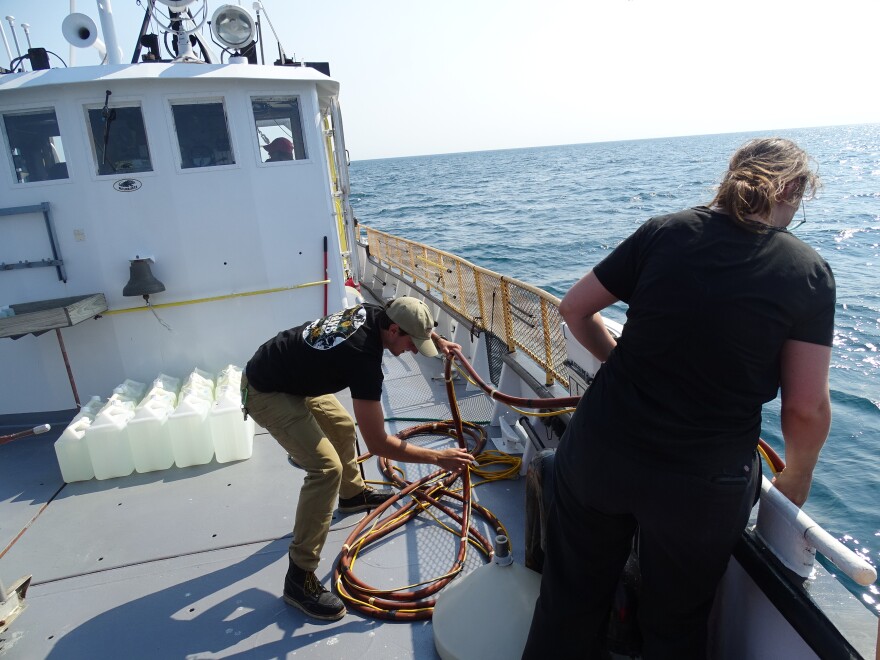UWM School of Freshwater Sciences researcher Jim Waples and his two grad students spent much of the summer in the lab and on the Neeskay — that’s the School's research vessel.
I joined them in July as the Neeskay headed south out of the Milwaukee harbor toward the Green Can. That’s the name insiders have for a nearby reef. It’s there Waples and his students were headed to gather water samples that day.
“They’ve got a submersible pump on a hose. We start pumping water. And today we’re looking for samples from three meters, 10 meters and 17 meters deep. From that water we’ll go back to the lab and spend a long time isolating these three radionuclide we’re interested in: lead 210, bismuth 210 and Polonium 210,” Waples explains.
Radionuclides are a particular type of naturally occurring atom that experiences radioactive decay. Waples says every element on Earth has at least one radionuclide — some have a couple dozen.
Each radionuclide has a unique half-life. That means some decay in a matter of minutes, others over billions of years.
“You can call them nature’s clocks. They decay at a precisely known rate and we know what that rate is and there are all sorts of applications,” Waples says.
Waples says radionuclides are fantastic tools for researchers because of another interesting phenomeno, when a radionuclide decays, it turns into a different radionuclide with different chemical properties.
“That’s why we’re going out here — demonstrating that we can track particle transport in shallow, really dynamic water, which again is very hard to do," Waples says.

Over the summer, Waples' team gathered samples from the same site once a week over a period of weeks.
Waples says back in the lab, graduate student Gage Hunter uses the properties of three radionuclides to calculate how much organic carbon makes its way from the water column to the lakebed below.

“Hoping to find out, based on the analysis of those radionuclides, how quickly particles, including food, juicy chunks of organic carbon, how quickly those particles are being removed from the water column. And Rachel’s looking on the other side,” Waples says.
He’s referring to graduate student Rachel Smith.
Waples says she’s studying invasive quagga mussels that have been having a field day, tipping the food chain upside down. The mussels have gobbled up phytoplankton, the foundation of Lake Michigan’s food chain.
“She can tell how fast the mussels are taking up this juicy food from the water column. So, two different approaches kind of getting at the same thing, and hopefully, these results are fairly close to one another,” Waples says.
The National Science Foundation recognizes the importance of Waples’ research and is funding it.

Graduate student Rachel Smith calls the project a little bit experimental. "It is an experiment to see if we can measure the Polonium (a radionuclide) in the tissue of the quagga mussel and in the water column and the amount that's coming from the atmosphere and use all of that information as like puzzle pieces to solve some bigger questions. Like where the quagga mussels get nutrients from, trying to understand the carbon system better," Smith says.
So really, the research boils down to carbon.
The team’s work on Lake Michigan could help fill gaps in what scientists have yet to learn about the element — carbon’s continual cycling from the atmosphere, to earth and back into the atmosphere.
“How much CO₂ can Lake Michigan store; what’s the time scales for tha?” Smith says.
There’s no time for pondering those questions.
Back in the lab, graduate student Gage Hunter says there’s loads of water samples to process — some in 20-liter containers, others 10-liter.
Hunter’s tasks include cutting each filter into tiny pieces and then dropping them into individual beakers.

"And then I'm going to place it on one of these hot plates where it will boil and dissolve," Hunter says.
Hunter says before working with Waples he wanted to be a doctor. Now he intends to dedicate his life to teaching and research.
He wants to be part of puzzling out the chemistry of the Great Lakes, a necessary step in tackling the climate crisis.
“It matters a lot to me to get it right. Just something I didn't expect to happen,” Hunter says.
For now, Hunter is consumed in the task at hand inside a lab full of beakers, chemicals, and gallons of Lake Michigan water, and questions to be answered.
_






